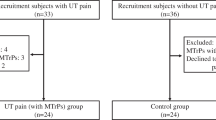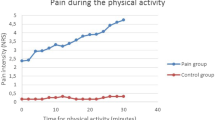Abstract
Muscle function is altered in painful shoulder conditions. However, the influence of shoulder pain on muscle coordination of the shoulder has not been fully clarified. The aim of the present study was to examine the effect of experimentally induced shoulder pain on shoulder muscle function. Eleven healthy men (range 22–27 years), with no history of shoulder or cervical problems, were included in the study. Pain was induced by 5% hypertonic saline injections into the supraspinatus muscle or subacromially. Seated in a shoulder machine, subjects performed standardized concentric abduction (0°–105°) at a speed of approximately 120°/s, controlled by a metronome. During abduction, electromyographic (EMG) activity was recorded by intramuscular wire electrodes inserted in two deeply located shoulder muscles and by surface-electrodes over six superficially located shoulder muscles. EMG was recorded before pain, during pain and after pain had subsided and pain intensity was continuously scored on a visual analog scale (VAS). During abduction, experimentally induced pain in the supraspinatus muscle caused a significant decrease in activity of the anterior deltoid, upper trapezius and the infraspinatus and an increase in activity of lower trapezius and latissimus dorsi muscles. Following subacromial injection a significantly increased muscle activity was seen in the lower trapezius, the serratus anterior and the latissimus dorsi muscles. In conclusion, this study shows that acute pain both subacromially and in the supraspinatus muscle modulates coordination of the shoulder muscles during voluntary movements. During painful conditions, an increased activity was detected in the antagonist (latissimus), which support the idea that localized pain affects muscle activation in a way that protects the painful structure. Further, the changes in muscle activity following subacromial pain induction tend to expand the subacromial space and thereby decrease the load on the painful structures.




Similar content being viewed by others
References
Bagg SD, Forrest WJ (1986) Electromyographic study of the scapular rotators during arm abduction in the scapular plane. Am J Phys Med 65:111–124
Bigliani LU, Levine WN (1997) Subacromial impingement syndrome. J Bone Joint Surg Am 79:1854–1868
Delagi E, Perotto A, Lazatti J (1981) Anatomic Guide for the electromyographer, vol 2nd. Charles C Thomas, Springfield
Diederichsen LP, Norregaard J, Dyhre-Poulsen P, Winther A, Tufekovic G, Bandholm T, Rasmussen LR, Krogsgaard M (2007) The effect of handedness on electromyographic activity of human shoulder muscles during movement. J Electromyogr Kinesiol 17:410–419
Falla D, Farina D, Graven-Nielsen T (2007) Experimental muscle pain results in reorganization of coordination among trapezius muscle subdivisions during repetitive shoulder flexion. Exp Brain Res 178:385–393
Gardner E (1948) The innervation of the shoulder joint. Anat Rec 102:1–18
Ge HY, Wang K, Madeleine P, Svensson P, Sessle BJ, Arendt-Nielsen L (2004) Simultaneous modulation of the exteroceptive suppression periods in the trapezius and temporalis muscles by experimental muscle pain. Clin Neurophysiol 115:1399–1408
Gerber C, Galantay RV, Hersche O (1998) The pattern of pain produced by irritation of the acromioclavicular joint and the subacromial space. J Shoulder Elbow Surg 7:352–355
Glousman R, Jobe F, Tibone J, Moynes D, Antonelli D, Perry J (1988) Dynamic electromyographic analysis of the throwing shoulder with glenohumeral instability. J Bone Joint Surg Am 70:220–226
Graichen H, Bonel H, Stammberger T, Haubner M, Rohrer H, Englmeier KH, Reiser M, Eckstein F (1999) Three-dimensional analysis of the width of the subacromial space in healthy subjects and patients with impingement syndrome. AJR Am J Roentgenol 172:1081–1086
Graichen H, Stammberger T, Bonel H, Wiedemann E, Englmeier KH, Reiser M, Eckstein F (2001) Three-dimensional analysis of shoulder girdle and supraspinatus motion patterns in patients with impingement syndrome. J Orthop Res 19:1192–1198
Graven-Nielsen T, Svensson P, Arendt-Nielsen L (1997) Effects of experimental muscle pain on muscle activity and co-ordination during static and dynamic motor function. Electroencephalogr Clin Neurophysiol 105:156–164
Halder AM, Zhao KD, Odriscoll SW, Morrey BF, An KN (2001) Dynamic contributions to superior shoulder stability. J Orthop Res 19:206–212
Hatch JP, Moore PJ, Cyr-Provost M, Boutros NN, Seleshi E, Borcherding S (1992) The use of electromyography and muscle palpation in the diagnosis of tension-type headache with and without pericranial muscle involvement. Pain 49:175–178
Hawkins RJ, Bokor DJ (1990) Clinical evaluation of shoulder problems. In: Rockwood CA, Matsen FA (eds) The shoulder, 2nd edn. WB Saunders, Philadelphia, pp 164–197
Hodges PW, Moseley GL, Gabrielsson A, Gandevia SC (2003) Experimental muscle pain changes feedforward postural responses of the trunk muscles. Exp Brain Res 151:262–271
Inman VT, Saunders JB, Abbott LC (1944) Observations of the function of the shoulder joint. J Bone Joint Surg 26:1–30
Johansson H, Sojka P (1991) Pathophysiological mechanisms involved in genesis and spread of muscular tension in occupational muscle pain and in chronic musculoskeletal pain syndromes: a hypothesis. Med Hypotheses 35:196–203
Kamen G, Caldwell GE (1996) Physiology and interpretation of the electromyogram. J Clin Neurophysiol 13:366–384
Kehl LJ, Fairbanks CA (2003) Experimental animal models of muscle pain and analgesia. Exerc Sport Sci Rev 31:188–194
Kellgren J (1938) Observations on referred pain arising from muscle. Clin Sci 3:175–190
Kellgren J (1939) On the distribution of pain arising from deep somatic structures with charts of segmental pain areas. Clin Sci 4:35–45
Kelly BT, Kadrmas WR, Kirkendall DT, Speer KP (1996) Optimal normalization tests for shoulder muscle activation: an electromyographic study. J Orthop Res 14:647–653
Kendall HO, Kendall FP (1949) Muscle testing and function. Williams and Wilkins, Baltimore
Kravitz E, Moore ME, Glaros A (1981) Paralumbar muscle activity in chronic low back pain. Arch Phys Med Rehabil 62:172–176
Kronberg M, Nemeth G, Brostrom LA (1990) Muscle activity and coordination in the normal shoulder. An electromyographic study. Clin Orthop (257):76–85
Kronberg M, Brostrom LA, Nemeth G (1991) Differences in shoulder muscle activity between patients with generalized joint laxity and normal controls. Clin Orthop (269):181–192
Ludewig PM, Cook TM (2000) Alterations in shoulder kinematics and associated muscle activity in people with symptoms of shoulder impingement. Phys Ther 80:276–291
Ludewig PM, Cook TM (2002) Translations of the humerus in persons with shoulder impingement symptoms. J Orthop Sports Phys Ther 32:248–259
Luime JJ, Koes BW, Hendriksen IJ, Burdorf A, Verhagen AP, Miedema HS, Verhaar JA (2004) Prevalence and incidence of shoulder pain in the general population; a systematic review. Scand J Rheumatol 33:73–81
Lukasiewicz AC, McClure P, Michener L, Pratt N, Sennett B (1999) Comparison of 3-dimensional scapular position and orientation between subjects with and without shoulder impingement. J Orthop Sports Phys Ther 29:574–583
Lund JP, Donga R, Widmer CG, Stohler CS (1991) The pain-adaptation model: a discussion of the relationship between chronic musculoskeletal pain and motor activity. Can J Physiol Pharmacol 69:683–694
Madeleine P, Lundager B, Voigt M, Arendt-Nielsen L (1999) Shoulder muscle co-ordination during chronic and acute experimental neck-shoulder pain. An occupational pain study. Eur J Appl Physiol Occup Physiol 79:127–140
Michaud M, Arsenault AB, Gravel D, Tremblay G, Simard TG (1987) Muscular compensatory mechanism in the presence of a tendinitis of the supraspinatus. Am J Phys Med 66:109–120
Neer CS (1972) Anterior acromioplasty for the chronic impingement syndrome in the shoulder: a preliminary report. J Bone Joint Surg Am 54:41–50
Nieminen H, Takala EP, Viikari-Juntura E (1993) Normalization of electromyogram in the neck-shoulder region. Eur J Appl Physiol Occup Physiol 67:199–207
Osu R, Franklin DW, Kato H, Gomi H, Domen K, Yoshioka T, Kawato M (2002) Short- and long-term changes in joint co-contraction associated with motor learning as revealed from surface EMG. J Neurophysiol 88:991–1004
Pallegama RW, Ranasinghe AW, Weerasinghe VS, Sitheeque MA (2004) Influence of masticatory muscle pain on electromyographic activities of cervical muscles in patients with myogenous temporomandibular disorders. J Oral Rehabil 31:423–429
Peat H, Graham RE (1977) Electromyographic analysis of soft tissue lesions affecting shoulder function. Am J Phys Med 56:223–240
Reddy AS, Mohr KJ, Pink MM, Jobe FW (2000) Electromyographic analysis of the deltoid and rotator cuff muscles in persons with subacromial impingement. J Shoulder Elbow Surg 9:519–523
Schuldt K, Harms-Ringdahl K (1988) Activity levels during isometric test contractions of neck and shoulder muscles. Scand J Rehabil Med 20:117–127
Schulte E, Ciubotariu A, Arendt-Nielsen L, Disselhorst-Klug C, Rau G, Graven-Nielsen T (2004) Experimental muscle pain increases trapezius muscle activity during sustained isometric contractions of arm muscles. Clin Neurophysiol 115:1767–1778
Svensson P, Arendt-Nielsen L (1995) Induction and assessment of experimental muscle pain. J Electromyogr Kinesiol 5:131–140
Svensson P, Arendt-Nielsen L, Houe L (1996) Sensory-motor interactions of human experimental unilateral jaw muscle pain: a quantitative analysis. Pain 64:241–249
Svensson P, Graven-Nielsen T, Matre D, Arendt-Nielsen L (1998) Experimental muscle pain does not cause long-lasting increases in resting electromyographic activity. Muscle Nerve 21:1382–1389
Thoroughman KA, Shadmehr R (1999) Electromyographic correlates of learning an internal model of reaching movements. J Neurosci 19:8573–8588
Turp JC, Schindler HJ, Pritsch M, Rong Q (2002) Antero-posterior activity changes in the superficial masseter muscle after exposure to experimental pain. Eur J Oral Sci 110:83–91
van der Helm FC (1994) Analysis of the kinematic and dynamic behavior of the shoulder mechanism. J Biomech 27:527–550
Westgaard RH, Vasseljen O, Holte KA (2001) Trapezius muscle activity as a risk indicator for shoulder and neck pain in female service workers with low biomechanical exposure. Ergonomics 44:339–353
Wolff BB, Potter JL, Vermeer WL, Mcewen C (1961) Quantitative measures of deep somatic pain: preliminary study with hypertonic saline. Clin Sci 20:345–350
Wrete M (1949) The innervation of the shoulder-joint in man. Acta Anat 7:173–188
Zedka M, Prochazka A, Knight B, Gillard D, Gauthier M (1999) Voluntary and reflex control of human back muscles during induced pain. J Physiol 520 Pt 2:591–604
Zuckerman JD, Rokito AS (1990) Occupational shoulder disorders. In: Rockwood CA, Matsen FA (eds) The shoulder, 2nd edn. WB Saunders, Philadelphia, pp 1296–1312
Acknowledgment
The study was supported by grant from the Danish Medical Research Council.
Author information
Authors and Affiliations
Corresponding author
Rights and permissions
About this article
Cite this article
Diederichsen, L.P., Winther, A., Dyhre-Poulsen, P. et al. The influence of experimentally induced pain on shoulder muscle activity. Exp Brain Res 194, 329–337 (2009). https://doi.org/10.1007/s00221-008-1701-5
Received:
Accepted:
Published:
Issue Date:
DOI: https://doi.org/10.1007/s00221-008-1701-5




